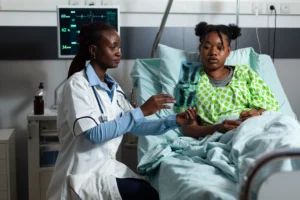
Situation
In Kenya, lung cancer presents a significant health challenge with its high fatality rates. According to the Kenya National Cancer Control Strategy 2017-2022, lung cancer accounted for 794 cases with 729 deaths and a prevalence of 1.75 per 100,000. This translates to a case fatality of 92 percent, ranking it 14th among all cancer types in the country. The financial burden of cancer treatment in Kenya is also substantial. A pilot study assessing the direct medical costs revealed that patients undergoing chemotherapy alone incur an average expense of KES 138,207 (USD 1,364.30). These high treatment costs place a considerable burden on households, often leading patients to rely on community fundraising from friends, family, and well-wishers to cover expenses. In some cases, patients may forgo treatment altogether due to financial constraints. The financial toxicity of cancer care in low- and middle-income countries like Kenya encompasses both objective financial burdens—such as direct and indirect care-related costs—and subjective financial distress, including material and psychosocial stress. These financial challenges are compounded by other barriers, including inadequate knowledge about cancer, poor health-seeking behavior, and long distances to access treatment facilities, all of which can compromise patient survival.

Solution
Recognizing this critical situation, a multinational pharmaceutical company, in collaboration with Axios International launched a Patient Assistance Program (PAP) in 2023. The PAP was designed to mitigate financial barriers, enabling patients to access timely treatments and improve their medical outcomes and quality of life. The PAP, complemented by the On Time Access (OTA) solution, helped cover the costs of supported treatments, removing cash flow constraints that often-delayed treatment initiation which is particularly detrimental for conditions like lung cancer where timely intervention is crucial for better health outcomes. The flexible, zero-interest installment payment model OTA allows patients to spread treatment costs over manageable payment schedules, eliminating the need for high upfront payments. Tailored financial support is provided based on each patient’s financial capacity, which is assessed using Axios’ validated Patient Financial Eligibility Tool (PFET). The solution ensures that patients receive immediate assistance to begin treatment without delays, improving both accessibility and health outcomes. By subsidizing treatment costs, the program reduces financial barriers and ensures patients can access life-saving medications at the right time.
Key features of the PAP include financial assessment through PFET to create realistic and personalized payment plans, partnerships with pharmaceutical firms, charities, and public and private entities to subsidize treatment costs, ensuring program sustainability and affordability for patients, and improved adherence and outcomes by addressing financial challenges, thereby, reducing dropout rates, and enhancing long-term health outcomes.
With a payment deviation rate of less than four (4) percent, the OTA model has proven to be a sustainable and effective solution for addressing cash flow issues while maintaining the integrity of the PAP.
Results
Since its introduction in 2023, the PAP has supported over 50 patients enrolled in the PAP. With high acceptance rates among both physicians and patients, the PAP, combined with OTA, has expedited treatment initiation, enabling patients to receive their medications within one month of enrolment. By addressing cash flow barriers, the program significantly reduces the likelihood of patients dropping out or discontinuing treatment, ensuring better adherence and improved health outcomes. Through this program, lung cancer patients in Kenya are now better equipped to access the care they need, fostering improved health outcomes and enhanced quality of life.

